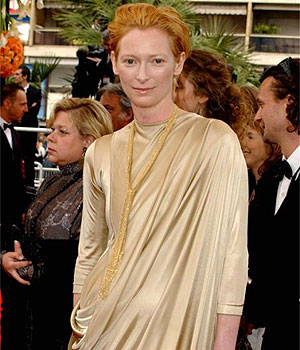But my thoughts were about fashion. I love vintage clothes. I love the uniqueness of an outfit not being something ANYONE ELSE IN THE WORLD could possibly be wearing (1940's dress, contemporary Primark heels, plus bag from 1980's that belonged to my mum and a necklace from Africa that is made of porcupine quills that was a gift from my old boss). I also enjoy the greenness of it all. Recycled, reused fabrics and items save our planet by refusing to add to the landfill and cause more waste! Hurrah! Plus I love the old cloths, the way of fastening a bag that seems rudimentary now and thusly obsolete, but which I think is just fab.
Now we are lucky to have fabrics that lasted from prehistoric times - little scraps that sit on mummified bones from Egypt. However, these are simple natural fibres - maybe this made them longer-lasting. My worry is that contemporary fashion is so fleeting (deliberately so to encourage profligacy and spending to help profit margins) that nothing will survive. We wont value it, so we wont keep it. Trunks of treasured items no more. They will be in the charity shop, then in the 'clothes for Africa' rag pile, then sold in Taiwan to poor families, then used as cleaning cloths when they are no longer wearable. Plus the items themselves are not built to last. In built obsolescence like washing machines (it is possible to build one that will last - it would be expensive and commercial suicide, but it is possible and would save our scrappage and subsequent re-mining for more raw materials) is resulting in poor quality clothes. A few washes and the cloth is pilled. A few more uses and the seams might go, embroidery unravels, beads fall off, printing fades. Still more use and the zip might break, a button will get lost and the elastic waistband gives way.
What will happen in 2110? One hundred years hence? Will they know what was fashionable? Will they look at trends? Will they know which tailoring styles were preferred, which fabrics, which colours? Will certain brand names remain: Gucci, NewLook, Nike? Could we look at different genders, different countries, different socio-economic groups and know what they would have worn or aspired to wear? What would these surviving clothes, textiles, magazines, catalogues, photographs, etc. tell us about the work that was conducted by these people? The type of homes they lived in? The social events they attended and the families they belonged to/created? History is excitingly discursive thus far and we can learn a lot about trade, class, etc. through people's wardrobes. Will be able to do this in the future?
I was wondering all this as we dawdled along a road and everyone seemed to be wearing something with Lycra in it - stretchy skirt......black, opaque tights.........fitted blouse.........neon leggings with the obligatory flat ballet pump. These elasticated items will shrivel and the elastic will degrade. The shape of the items might well be lost, how we wore them will be forgotten.
Satisfyingly sturdy craftsmanship sounds retro and expensive, but if we want to preserve our sartorial selves, we might need to think beyond the immediate. Savvy production now will help the fashion historians of the future.

Along the same vein, I am wondering how our current icons will be received in the eons to come. Will Helen Mirren be as memorable as Greta Garbo or Elizabeth Taylor? Ms. Mirren is held in high-esteem for her talent and her fortune to remain youthful and attractive in her advancing years. There is a lot of press coverage and we are moving towards her being part of the starry firmament with Dames Eileen Atkins and Judi Dench

What of Mary Portas? Her cinnamon bob is memorable as are her confident outfits and clunky shoes. She is her own woman (as we all should be) which I applaud and she looks fashionable, though I would say that she doesn't look stylish. There are a lot of her clothing choices that I don't think suit her. But it isn't any of my business; she doesn't care what I think and neither should she. But she is becoming an icon.
This emerging iconography is very interesting. How will the subjects see themselves in decades' time? 'Ooh, I can't believe I wore that red swim suit.' 'Where are those enormous rings that I used to port?' How will we respond as the audience?
Already we have some idea. One of the woemn in the public eye has aged and altered as expected since her 1980s debut. Madonna is another unique person who has been developing a varied personal style and stage presence, much to her credit. A fish that doesn't keep swimming dies - is that the old phrase? I think we have enjoyed Madonna's variety and braveness.
I wonder who will be the next icon with longevity enough that we can map their progress and enjoy the changes in their personna personnified. I think Tilda Swinton is a good bet. She will only get more beautiful as she ages. Though I think her style is unlikely to change much. She has a happy berth, wide enough for creativity but within a range of cuts that keeps her looking like Tilda. If we ever saw her in cropped top with padded bra, miniskirt and heels, we would be confused. That isn't where she sits on our radar. 'Genderbending-simplicity-on-a-genuinely-lithe-frame' is what we expect.
Actually, I might be wrong; Ms. Swinton doesn't look that unexpected in this outfit:


















No comments:
Post a Comment